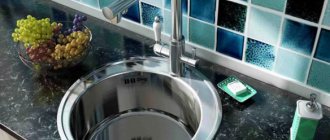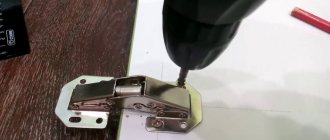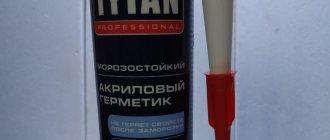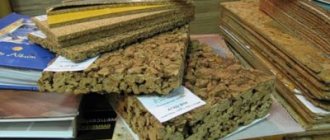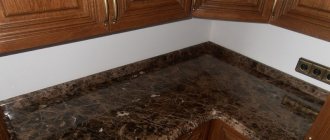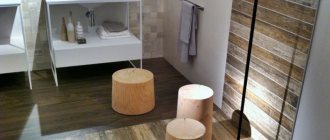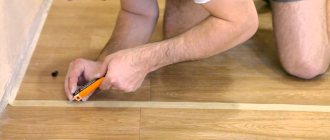A relatively new method of sealing a transition joint involves the use of a special type of sealant. This is a specially developed version of the sealing compound, known as liquid cork, for laminate and tile joints. A very interesting and useful solution, although the attitude towards it is ambiguous. You can make the floor in the kitchen incredibly beautiful and impressive, but if you do not solve the problem of sealing and decorating the joint, the result of so much effort will go down the drain.
Decorative transition from laminate to tile
Features of sealing joints between tiles and laminate with cork
For most floor coverings consisting of two or more types of materials, creating a transition joint has always caused technological difficulties. Typically, the joint between tiles and laminate was closed in three ways:
- Decorative rigid lining protruding above the floor level. It is inconvenient when walking, you can stumble, debris accumulates, especially on the laminate side, over time the surface is wiped and loses its appearance;
- Laying a tape made of natural cork. The cork threshold between the laminate and tile worked great. It turned out beautifully, but not very durable;
- Seal with sealant. The seam is narrow, but not beautiful and reliable enough.
For your information! Laminate, especially on MDF, tends to expand and “play” under load, so the joint between the lamella and the tile must be elastic, which means a rigid overlay will not work.
I seal the joint with a mixture of crumbs and sealant
The problem was solved by developing a new material. The cork connector for laminate and tile was replaced with a sealant that uses natural cork chips as a filler.
Using liquid cork for interior decoration
For those who are in the process of renovation, the building materials market offers materials for every taste and budget. Among them, liquid plug is not the least important. This material is a crushed suspension of balsa wood chips in a binding glue.
Purpose
Liquid cork can be used as a sealant, sound insulator, insulation, and also as a material for cladding interior walls and facades.
This material can be used wherever it is necessary to ensure noise insulation, tightness, and thermal insulation. The sealant will cope with these tasks perfectly. In addition, the conditions for working with liquid plug are quite simple, so you can handle it yourself without the help of a specialist.
Sealant based on liquid plug
Advantages
Liquid cork sealant can be used in many areas of construction and repair. In addition, it has the following advantages:
- naturalness of the material;
- resistance to mechanical stress;
- high thermal insulation properties;
- resistance to temperature changes;
- elasticity;
- high adhesion to various materials.
Advantages of the material
Liquid cork does not shrink, so it can be used without fear of damaging the finish.
Rules for joining different coatings
Often during renovation work there is a need to join different finishing coatings, and the transition should be smooth and discreet. Depending on the purpose of the room, certain material is placed there. For example, tiles are installed in the kitchen, and laminate flooring is installed in the hallway.
Sometimes different materials are placed in the same room to divide the room into work and guest areas.
Joining tiles with parquet
Liquid stopper for laminate and tile joints is one of the options for connecting these coatings. This work is simple, but requires preliminary preparation of the seams. First, the seam is treated with oil and then filled with liquid cork. After the material has dried, the residues are carefully removed with a knife, and then the surface of the seam is sanded. These simple steps will help make the seam between different types of coatings neat and inconspicuous.
For joints
The parameters of liquid cork sealant allow it to be used for sealing joints between any coatings or a coating and a wall. Liquid cork will create a reliable and elastic adhesion between coatings, which is not afraid of either deformation of the coatings or temperature changes.
Sealant seam
This sealant can also be used to insulate window and door openings. If drafts are a concern, then treating the slopes of a window or door will help solve this problem.
For joints, it is best to use bostik 3070 sealant, which is recommended to be protected from weathering with elastic sealants.
For facades and interior walls
Facade finishing
An excellent solution for finishing the facade would be to use soft cork. Thanks to its properties, the connecting material will prevent the façade surface from becoming dirty and will protect against moisture, noise and vibration. In addition, the appearance of the facade will look natural and quite rich, despite the cheapness of the material.
Advantages and disadvantages of cork joints between tiles and laminate
At first glance, the decision is ambiguous. Cork grout between tiles and laminate does not provide any special advantages, and the plastic consistency only complicates the work with the sealant.
Unobvious advantages of liquid plug
If the new material were worse than the sealant, then its production would not exceed the volume of cork tapes previously used to seal joints on laminate flooring.
The main advantages of the material:
- Fully similar to natural cork, the sealed joint looks just as beautiful as when using a tape gasket;
- After laying the material in the joint between the seal and the edge of the laminate, there are no gaps where dust and dirt could accumulate;
- Soft texture and high plasticity. The sealant and natural cork turn out to be too hard and not very flexible to compensate for the expansion of the lamella by more than 0.5-1.0 mm.
For small rooms, silicone is still enough, but if the room has one of the dimensions of more than 5 m, the expansion of the material reaches 2.5-4 mm, which is clearly beyond the capabilities of the silicone mass.
Cork has high vapor permeability
Important! After hardening, liquid cork takes on the appearance of natural wood, and its characteristics resemble very soft spongy rubber.
Disadvantages of cork silicone
The new material also has enough negative qualities:
- The width of the joint between the edge of the lamella and the tile cannot be less than 5-6 mm, the maximum size is 15 mm. It is very difficult to press a liquid plug into a narrower gap; at a wide joint, the material loses its decorative qualities;
- The process of filling the seam with cork between the laminate panel and the tile turns out to be very long and quite labor-intensive.
Large chips of cork with silicone “fit” into the joint very poorly; you have to put in considerable effort and waste time to press the “inconvenient” mass into the narrow gap. In addition, the mixture adheres well to the laminated surface.
Description of cork sealants
These sealing products are based on fine cork chips, which constitute about 90-95 percent of the total volume. In addition, the substance contains specialized polymer substances, water, fillers and binders that make cork sealants of the required thickness and texture. Depending on the quality of the cork, the quality of the sealing composition will be worse or better. The best raw materials are obtained from oak bark, a type of cork tree. Sealants based on such oak bark have a significantly higher cost than substitutes made from any other type of wood.
When cork sealants cure, they acquire the following characteristics:
- small mass;
- excellent elasticity and sufficient resilience;
- low heat conductivity;
- environmental cleanliness and safety;
- resistance to chemicals and physical and mechanical influences.
Depending on the type of binders present in the sealant, it will have certain characteristics. Typically, polyacrylate glue is used as binding components, which is a water-soluble mixture that does not release harmful or toxic substances during hardening. Polyacrylates increase the adhesion (adhesion) rate of cork sealant with various types of materials, such as, for example, tiles, laminate, parquet and others. Polyacrylates combine well with cork coatings and eliminate certain disadvantages of these seams and surfaces, for example, poor resistance to ultraviolet rays, acidic environments, and low hygroscopicity.
How to choose liquid cork compensator for tiles and laminate
In order for the joint to be smooth and beautiful, it is best to use a cork in half-liter film tubes for a syringe gun. In addition, transparent film allows you to see the real color of the material, and it may differ even from the same manufacturer.
It is more convenient to work with plastic boxes if the joint width is no more than 6 mm. There are a limited number of colors of liquid compensator available for sale, so you need to decide on the shades of the cork seal in advance.
High quality mixture for sealing joints on laminate flooring
Cork silicone from French is considered to be of the highest quality; Russian brands “Isocork” and “Nanocork” will cost a little less.
How to make a cork insert between tiles and laminate
The material dries quickly, so basic preparatory work must be completed long before laying the silicone plug in the joint between two floor coverings:
- Using a hand router, the edge of the lamella is aligned;
- The cut shavings and sawdust are blown dry with a vacuum cleaner;
- The inner surface is treated with a primer, which facilitates the adhesion of the sealant to the cement base.
The material is applied using a syringe; it is not possible to seal the joint quickly and beautifully with a spatula or other tool. The liquid sealant is laid, as they say, “heaped”, so that it protrudes 2-3 mm above the level of the lamella. After the cushioning layer has set, soapy water or oil is applied to its surface and the excess is cut off with a sharp blade of a stationery knife.
Cutting the top layer requires certain skills, so before laying it will be useful to first practice on scraps of lamellas.
Common mistakes during application
When using liquid stopper yourself, it is important to take into account the nuances that will help prevent mistakes when working with this material.
Sealant liquid plug
- Firstly, before use, you should carefully prepare the surface from moisture, dust, and grease. Otherwise, contamination will reduce the adhesion of the sealant.
- Secondly, after applying the liquid plug, its excess should be cleaned off immediately, otherwise it will harden and require mechanical removal. This can lead to damage to the coating and seam edges.
- Thirdly, you should not level the liquid plug on a surface that is higher than the level. Otherwise, there may be a lack of a tight fit and the presence of gaps.
- Fourthly, the material is not used to seal the joints of carpeting with other coverings.
Liquid cork sealant can be safely called a universal material. The range of its applications is quite wide: from wall decor to sealing seams. By purchasing a sealant at an affordable price, the result is an excellent quality material with characteristics no worse than its expensive counterparts.
Did the article help you? ( 11 ratings, average: 4.27 out of 5)

